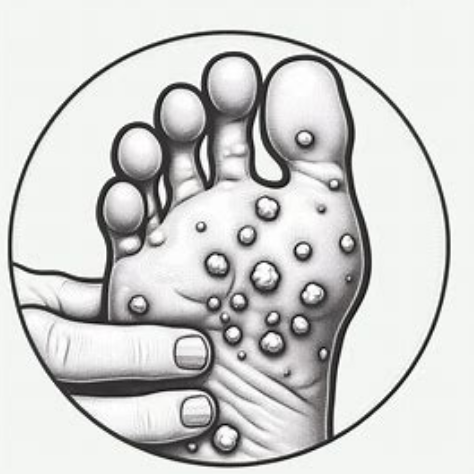Corns and Calluses
Corns and calluses are hyperkeratotic skin conditions commonly encountered in clinical podiatric practice. They arise as a protective response to repeated mechanical stress, typically due to friction and pressure. Although often conflated, corns and calluses differ in appearance, location, and symptomatology.

Corns and Calluses: Definitions and Distinctions
- Corns (Clavi): Localized, well-demarcated areas of thickened skin, usually found on non-weight-bearing parts of the feet such as the dorsal and lateral aspects of toes. Corns may be hard (heloma durum) or soft (heloma molle), with a central core that can cause significant discomfort, especially under pressure.
- Calluses (Tylomas): Diffuse, flattened areas of hyperkeratosis typically forming on weight-bearing regions such as the plantar aspect of the foot. Calluses are generally asymptomatic but may lead to pain or fissuring if left untreated.
Etiology
- Ill-fitting footwear or high heels
- Biomechanical abnormalities (e.g., hammertoes, bunions)
- Gait irregularities
- Occupational or activity-related stress
- Walking barefoot on hard surfaces
Clinical Presentation
- Localized thickening of the stratum corneum
- Pain on direct pressure (corns)
- Diffuse keratotic patches with or without discomfort (calluses)
- Occasional erythema or fissures in surrounding skin
Preventive Strategies
- Use of properly fitted, supportive footwear with adequate cushioning
- Orthotic devices or padding to redistribute pressure
- Regular moisturization with urea-based creams
- Proper foot hygiene and routine care
- Periodic podiatric evaluation for at-risk populations (e.g., diabetics)
Therapeutic Interventions
- Debridement by a trained podiatrist
- Keratolytic agents containing urea, salicylic acid, or ammonium lactate
- Pumice stone or mechanical filing after soaking
- Custom orthotics for pressure relief
- Avoidance of over-the-counter medicated corn plasters without supervision, especially in diabetic patients
When to Seek Medical Attention
- Presence of ulceration, infection, or bleeding
- Severe pain impairing ambulation
- Signs of cellulitis or inflammation
- Underlying systemic conditions such as peripheral neuropathy or vascular disease
Conclusion
While corns and calluses are benign dermatologic manifestations, they may be indicative of underlying biomechanical issues and can significantly impair quality of life if neglected. Early identification and proper management, especially for high-risk patients, are essential for preventing complications. Consultation with a licensed podiatrist ensures comprehensive care and long-term resolution.
